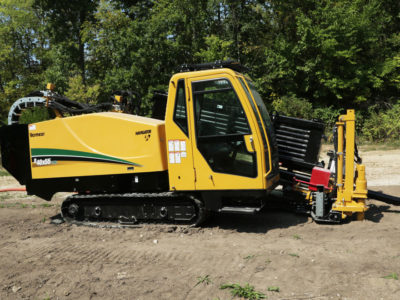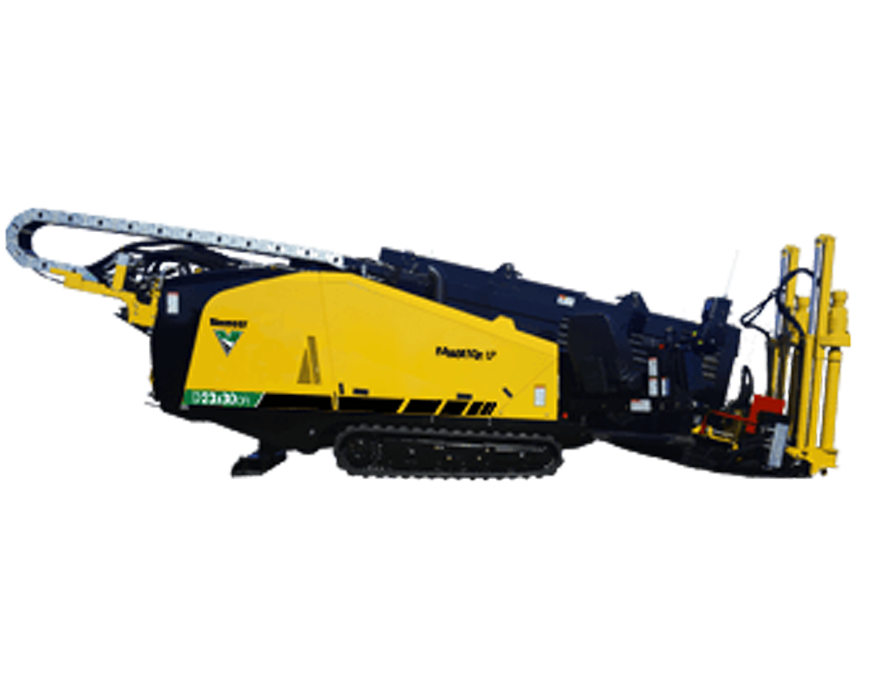Choosing the right size horizontal directional drill (HDD) for utility work can be a real challenge. Trying to manage multiple customers in multiple locations and varying ground conditions can sometimes feel like a moving target. The model that worked yesterday may not be the right one for the next project.
If you’re looking for ways to narrow your utility directional drill search, Tod Michael, cutting edge business unit manager at Vermeer, recommends reviewing these four factors:
- Bore specifications — When comparing the work your crews spend the bulk of their time on, what are the bore profile averages?
- Jobsite conditions — Where are your crews working, and what are the ground conditions like?
- Transportability — What else are you sending to the job with your crew, and what size trucks and trailers are you using to get it there?
- Fleet preference — How many crews are you running, and are you looking to standardize your fleets or expand your capabilities range?
Bore specifications
“The first factor contractors need to consider before adding a directional drill for utility work is the size of the installed product and bore distances,” explained Michael. “As bore diameter steps up in size or distance, so does the thrust and pullback requirements, as well as the drill’s size and tooling requirements to perform the work. Manufacturers set their utility directional drill line based on those ranges.”
Drills like the Vermeer D8x12 and D10x15 S3 HDD are designed for smaller-diameter work (up to 4 inches [10.2 cm] and 8 inches [20.3 cm], respectively) at shorter distances (ranging up to 300 feet [91.4 m] and 450 feet [137.2 m]) in most ground conditions. On the larger end of the spectrum is the midsize D60x90 S3 HDD. This drill can install products 20 inches (50.8 cm) in diameter at ranges up to 1,800 feet (548.6 m), depending on ground conditions. After that, you graduate into maxi rig drill sizes.
“From the smallest drill in the product line to the largest, there are ranges where each drill model will overlap in capabilities,” Michael said. “Those overlaps are when it gets to be a little more challenging to decide what utility drill to choose. Choosing a smaller drill gives a contractor greater flexibility on a jobsite. It can fit through gates. It won’t take up as much space when working in urban environments as a larger drill. However, a larger drill has more horsepower, which translates into thrust and pullback.”
Larger drills also are equipped with drill rods that have a large inside diameter. So, they can bore longer distances than a smaller drill. They can handle greater volumes of mud, which can be critical when working in certain soil types. While smaller drills using smaller drill rods can be more flexible and allow for tighter steering corrections. In congested areas, where the bore profile calls for extensive steering, flexibility can be a significant advantage and reduce setback requirements when drilling deep.
Michael’s pro tip: Start your utility directional drill search by determining which model is the smallest unit you can use without putting the success of a project at risk and the largest machine that fits your need.
Jobsite conditions
The next factor in determining what is the right directional drill for utility installations is jobsite conditions. Michael says you need to consider above-ground and below-ground conditions here. “In urban environments, machines with a small footprint may be more productive than a drill that can drill out farther,” he explained. “Larger drills may mean having to close lanes of traffic and/or setting back farther because of space constraints. On the other hand, longer drill shots can reduce the number of bores needed, which also means less repositions on a project.”
In more residential areas, Michael notes you should also think about public perceptions. “Many contractors choose to use small drills here because some residents may have concerns about potential property damage larger drills could cause. In most instances, those concerns are unfounded, but there’s a perception that goes along with large construction equipment.”
Michael’s pro tip: Speed, sound and simplicity are trademarks of the entire Vermeer S3 drill lineup. And the sound level is an important attribute to pay attention to when working in residential areas.
What’s happening below ground is also something you must think about. Soil conditions can have a major impact on identifying the optimal directional drill for your needs. “If a crew is working on rocky grounds regularly, a dual rod machine like the Vermeer D23x30DR S3 or D40x55DR S3 HDD may be the right choice. For infrequent rock work, investing in an air hammer or the Vermeer Armor drilling system may be a better option.”
For soil conditions like sand, where higher volumes and a specific mixture of drilling fluid may be required for bore hole integrity, a larger drill with more fluid capacity may be the correct choice.
Transportability
As you narrow your search for the ideal utility directional drill for your work, how you get it to and from the job must be considered. Bigger drills weigh more than smaller ones do, so you’ll need a larger truck and trailer to pull it there. Michael says some communication companies use small drills like the D8x12 HDD because they can set up their trucks and trailers to come below commercial driver’s license (CDL) weight requirements. “Creative thinking like this can impact their hiring requirements, which can be a competitive advantage when quality help is hard to find,” he explained.
Drill weight isn’t the only thing to consider when it comes to transportability. You need to look at the whole package — truck, trailer, drill, mix system and tooling. “Incremental increases in costs as the total equipment package increases in size is something contractors need to think through,” said Michael. “In some cases, the same truck, truck trailer, mixing system and tool can support a few different drill models. So, a contractor may want to add the more powerful (bigger) drill when trying to decide between a couple of models.”
Michael’s pro tip: When determining how transporting equipment to and from the job impacts your buying decision, you need to balance operational costs with productivity. Depending on your operation, travel distance, jobsite space, bore length and diameter, you may find that being nimble in transport may outweigh drill power and productivity. The key is determining what is most important to your business.
Fleet preference
The last factor to consider when shopping for a new utility drill comes down to your personal fleet preference and size. Are you looking to expand the range of work your company can do? Or do you want to standardize your crews, so it’s easy to stock parts, tooling and wear parts?
Michael says there’s no wrong answer here. “A lot of smaller contractors or companies that specialize in a certain area may choose to add multiple drill models to give them greater flexibility to adapt to customer needs,” he said. “Larger companies may tend to prefer to stick to a couple of drill models to make it easier to manage their large equipment fleet. Other contractors may choose a particular model because they can get a specific feature, like a cab with it.”
Michael’s pro tip: The smallest to the larger Vermeer utility directional drill models all share common controls. So, if you’re trained to operate one, you’ll be able to adapt to any Vermeer drill quickly.
Decision time
Just a quick recap — when you’re trying to decide which horizontal directional drill is right for your utility installation needs, start with narrowing your search through bore diameter and distance specifications. From there, consider the jobsite conditions above and below ground. Next, you want to look at your transportation expense and how it will impact your total operational costs. And then finally, compare your decision to your fleet preferences.
If you need any help along the way, contact your local Vermeer dealer. Their team can walk you through all the details. Learn more about the complete Vermeer utility directional drill product line today.
Vermeer Corporation reserves the right to make changes in engineering, design and specifications; add improvements; or discontinue manufacturing at any time without notice or obligation. Equipment shown is for illustrative purposes only and may display optional accessories or components specific to their global region. Please contact your local Vermeer dealer for more information on machine specifications. Vermeer and the Vermeer logo are trademarks of Vermeer Manufacturing Company in the U.S. and/or other countries. © 2021 Vermeer Corporation. All Rights Reserved.

